Papers by Tarakeswar Shaw
2019 IEEE MTT-S International Microwave and RF Conference (IMARC)
In this paper, a simple, miniaturized, flexible device has been introduced for composition detect... more In this paper, a simple, miniaturized, flexible device has been introduced for composition detection of a liquid. The proposed 7mm × 7mm × 0.17mm structure offers higher sensitivity compared to the previously reported sensors operating in microwave regime. The sensitivity is about 0.53% using only 18.24 μL sample. The novelty lies in its flexibility in contrast to the other sensors for liquid characterization making it compatible to wearable, real time and on body sensing applications. In addition, the introduced numerical equations facilitate the dielectric properties’ evaluation of an unknown liquid.
2017 IEEE MTT-S International Microwave and RF Conference (IMaRC)
In this paper, a simple and efficient approach is presented for the design of a metamaterial base... more In this paper, a simple and efficient approach is presented for the design of a metamaterial based high sensitive chemical sensor. The sensor is designed by incorporating metamaterial Split Ring Resonator (SRR) unit cell within a small square loop. A high Quality-factor of 419 is obtained for the proposed design which is highly desirable in the field of sensing applications. Here, the proposed configuration is applied for chemical discrimination. The experimental results for various liquid samples, such as distilled water, alcohol and acetone are discussed. Also, the measurement of these three liquid mixtures is performed. The proposed metamaterial based sensor is small in size and compact in its shape.

2019 IEEE MTT-S International Microwave and RF Conference (IMARC), 2019
In this paper, we present the design of a simple, compact and fully planar magnetic resonance cou... more In this paper, we present the design of a simple, compact and fully planar magnetic resonance coupled (MRC) based wireless power transfer (WPT) system. The system is designed to operate at the ISM of 2.45 GHz. In the proposed design, the transmitting (Tx) and receiving (Rx) sections are constructed with the help of identical planar source/load loop and resonating coils on the same face of the dielectric substrate. The use of planar structure eliminates the limitation of the practical applicability caused by the bulky geometry of the non-planar configurations. Further, to improve the power transfer efficiency of the proposed system, a zero-index MTM slab is placed between the Tx and Rx section. The MTM slab controls the wave directivity of the Tx element according to Snell’s law and improved the coupling between the Tx and Rx section. As a result, the efficiency of the proposed system is improved significantly. To justify the proposed approach, the prototypes are designed and experimentally verified. The experimental result confirms the feasibility of the proposed system.

2021 IEEE Indian Conference on Antennas and Propagation (InCAP), 2021
In this paper, we study the feasibility of adopting an alternative miniaturization technique of a... more In this paper, we study the feasibility of adopting an alternative miniaturization technique of a CPW fed rectangular slot antenna by using unusual property of metamaterial (MTM). By applying the MTM slab, the resonant frequency of the antenna has been reduced significantly. An array combination of 1 × 3 one-sided periodic structure of split ring resonator (SRR) is used to design the MTM slab. In the proposed configuration, the slot antenna is placed above the MTM slab to obtain miniaturization. Due to the high value of permittivity and permeability of the MTM, the guided wavelength is decreased as a consequence, miniaturization is attained. The cross-polarization of the proposed design is reduced with minimal effect on co-polarization performance. Also, high efficiency of about 87.6% is obtained along with compactness for the proposed antenna.
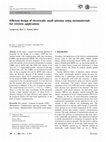
CSI Transactions on ICT, 2017
In this paper, a simple and efficient approach is presented for the design of a compact CPW fed s... more In this paper, a simple and efficient approach is presented for the design of a compact CPW fed slot antenna loaded with complementary split ring resonators (CSRRs) and metamaterial (MTM) slab. It has been shown that the fundamental resonant frequency of the conventional slot antenna can be lowered considerably by loading CSRRs and an MTM slab. The MTM slab consists of an array of 1 9 3 single-sided periodic structure of split ring resonator unit cells. The CSRRs are incorporated on both sides of the rectangular slot and the MTM slab is placed below the dielectric substrate of the antenna to achieve miniaturization. About 56.7% miniaturization is attained for the proposed CSRRs and MTM slab loaded antenna in comparison to the conventional antenna. It is also observed that the minimal effect on the co-polarization and crosspolarization is obtained in the case of proposed antenna. The overall antenna size is 0.23 k 0 9 0.23 k 0 9 0.009 k 0 , where k 0 is the free space wavelength. In this proposed antenna a high radiation efficiency of about 84.2% is obtained. Owing to the high efficiency and compact size, the proposed antenna will find broad applications in the field of wireless communication.

2019 IEEE Indian Conference on Antennas and Propogation (InCAP), 2019
In this paper, the design and analysis of an efficient wireless power transfer (WPT) system to po... more In this paper, the design and analysis of an efficient wireless power transfer (WPT) system to power the bio-implantable medical devices is presented. Herein, the radiating principle of the antenna is utilized to design the proposed system. A CPW fed ring slot antenna is considered as receiving (Rx) element, whereas a simple patch antenna is used as transmitting (Tx) element to construct the WPT link. The system is designed to operate at the industrial, scientific, and medical (ISM) band of 2.45 GHz. The alumina coating is used around the implant ring slot to eliminate the direct contact with skin tissue and make the Rx antenna bio-compatible. Also, a metamaterial slab with zero-index property is placed above the skin layer in the proposed design to improve the power transfer efficiency of the system. Furthermore, the misalignments between the Tx and Rx elements is studied to show the practical applicability of the proposed design. Finally, the specific absorption rate (SAR) analysis is performed to indicate the effect of the WPT system on the human skin tissue model.
2017 International Conference on Multimedia, Signal Processing and Communication Technologies (IMPACT), 2017
In this paper, a miniaturized and multiband antenna without compromising their efficiency and ban... more In this paper, a miniaturized and multiband antenna without compromising their efficiency and bandwidth is designed. The proposed technique combines a metallic spiral with a dipole antenna. Similarly using two metallic spirals in two dipole arms effective antenna size are reduced further and also have a better return loss. The reference dipole antenna structure resonates at 4.4 GHz. By using two metallic spirals, we have achieved 24.15% reduction in resonance frequency as well as double band. The resonant frequencies are determined by controlling the number of turns of the spirals. The bandwidth is also enhanced by changing the gap between the top and bottom spirals. By the presence of these spirals, it is seen that the radiation pattern of the proposed design are unaffected.

International Journal of RF and Microwave Computer‐Aided Engineering, 2021
In this article, a highly directive slot antenna design using a parallel incident magnetic metama... more In this article, a highly directive slot antenna design using a parallel incident magnetic metamaterial (MTM) structure has been presented. A split ring resonator (SRR) structure having mu near‐zero and epsilon very large with low impedance behavior is employed to enhance the directivity of the antenna. In the proposed optimized design, four‐MTM slabs with an array of 2×2 SRR unit cell have been placed perpendicularly over the slot antenna to enhance the directivity. The thickness of utilized MTM slab in the vertical direction is under the optimal condition, which is highly desired to obtain better improvement in directivity. In spite of directivity enhancement of about 6 dB, antenna miniaturization of 11.4% is also obtained due to the loading effect of the MTM slab. The proposed directivity enhancement approach of the slot antenna is established by simulation and verified by measurements. It is perceived from both measured and simulated results that over the whole working band, a s...

2018 IEEE MTT-S International Microwave and RF Conference (IMaRC), 2018
In this paper, an efficient approach for the efficiency enhancement of a single-sided planar wire... more In this paper, an efficient approach for the efficiency enhancement of a single-sided planar wireless power transfer (WPT) system has been proposed. Here, the efficiency improvement is obtained by controlling the transmission and reflection properties of metamaterials (MTMs). An array of 4×4 double-sided ring structured unit cell is placed between the transmitter (Tx) and the receiver (Rx) elements which enhanced the efficiency by about 15% compared to the system without the MTM slab at a distance of 10 mm. For further improvement of efficiency, a 4×4 array of double-sided ring structure which acts as a reflector is placed behind the Tx element to direct the backward radiated power towards the Rx side. In the proposed WPT model, by controlling the transmission and reflection property of MTM slabs, we are able to improve the efficiency by 27%.

2020 14th European Conference on Antennas and Propagation (EuCAP), 2020
In this paper, a wireless power transfer (WPT) system design for charging the bio-implantable dev... more In this paper, a wireless power transfer (WPT) system design for charging the bio-implantable devices in the reactive near-field of the antenna is presented. The proposed system is designed to operate in the industrial, scientific, and medical (ISM) of $2.40-2.4S$ GHz band. The WPT link is constructed with dual-ring slot antenna implanted in a single layer skin tissue model is used as a receiving (Rx) element and a simple patch antenna considered as transmitting (Tx) element. The patch antenna is designed to operate at the ISM of 2.45 GHz, whereas the dual-ring slot is used to obtain wideband characteristics that cover the entire ISM band. The strong mutual coupling between the Tx and Rx elements in the reactive near-field provide high power transfer efficiency for the proposed WPT system. Also, to reflect the real-life application scenario, the analysis of specific absorption rate (SAR) and misalignment between the Tx and Rx element is performed for the proposed system. Finally, th...

2019 IEEE Asia-Pacific Microwave Conference (APMC), 2019
This paper presents a simple and efficient wireless power transfer (WPT) system design for chargi... more This paper presents a simple and efficient wireless power transfer (WPT) system design for charging the implantable biomedical devices in the far-field region of antenna. The proposed system is designed to operate at the industrial, scientific, and medical (ISM) of 2.45 GHz. The WPT link is constructed with a simple patch antenna used as a transmitting (Tx) element and a miniaturized monopole antenna implanted in a single layer skin tissue model is considered as a receiving (Rx) element. To reflect the practical application scenario of the proposed design, the specific absorption rate (SAR) analysis is performed. Also, the lateral and angular misalignment is studied for the proposed design. Finally, the prototype of the Tx and Rx elements are fabricated and experimentally verified by using skin mimicking gel. The measured result shows good agreement with the simulated one.

IEEE Transactions on Antennas and Propagation, 2021
In this article, we present a novel approach for designing a rotation insensitive, biocompatible,... more In this article, we present a novel approach for designing a rotation insensitive, biocompatible, circular polarization-based efficient wireless power transfer (WPT) system for implantable medical devices (IMDs) in the radiative near-field region. Initially, a wideband, biocompatible, flexible circular polarized (CP) slot antenna is designed inside a single-layer skin tissue model to use as a receiving (Rx) element. To create the WPT link, a simple square patch antenna with the truncated corners is constructed to utilize as a transmitting (Tx) element. Furthermore, a polarization conversion-based metamaterial (MTM) structure is built particularly to improve the power transfer efficiency (PTE) of the proposed WPT system. Also, to show the versatility, the performance analysis of the proposed MTM integrated WPT system is conducted inside the human torso and head model. Moreover, a detailed study of the specific absorption rate (SAR) is accomplished regarding the safety of the human body in the light of IEEE regulation. Finally, the prototypes of the proposed WPT system are fabricated and experimentally verified in skin-mimicking gel and minced pork. The experimental result confirms the feasibility of the proposed concept by enhancing the PTE of the presented system by the usage of the MTM slab.
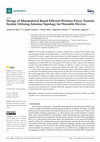
Sensors, 2021
In this article, the design of an efficient wireless power transfer (WPT) system using antenna-ba... more In this article, the design of an efficient wireless power transfer (WPT) system using antenna-based topology for the applications in wearable devices is presented. To implement the wearable WPT system, a simple circular patch antenna is initially designed on a flexible felt substrate by placing over a three-layer human tissue model to utilize as a receiving element. Meanwhile, a high gain circular patch antenna is also designed in the air environment to use as a transmitter for designing the wearable WPT link. The proposed WPT system is built to operate at the industrial, scientific and medical (ISM) band of 2.40–2.48 GHz. In addition, to improve the power transfer efficiency (PTE) of the system, a metamaterial (MTM) slab built with an array combination of 3 × 3 unit cells has been employed. Further, the performance analysis of the MTM integrated system is performed on the different portions of the human body like hand, head and torso model to present the versatile applicability of...
International Journal of RF and Microwave Computer-Aided Engineering, 2020
In this paper, we have presented a simple, miniaturized, and highly sensitive liquid sensor, whic... more In this paper, we have presented a simple, miniaturized, and highly sensitive liquid sensor, which determines the dielectric properties of liquids at microwave frequency. In the proposed design, the concept of interdigital capacitor (IDC) is employed to construct the sensor. The proposed IDC based sensor responds differently depending on the liquids' dielectric property. The proposed structure utilizes the shift in resonance frequency and peak attenuation as the sensing parameter to determine the complex dielectric permittivity of the unknown liquids. The advantage of the proposed sensor structure lies in its compactness (0.08λ 0 × 0.08λ 0 × 0.003λ 0) and high sensitivity, 0.42%. The designed sensor can also be used in the biomedical field for noninvasive bioliquid characterization.
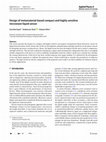
Applied Physics A, 2019
This article presents the design of a compact and highly sensitive mu-negative metamaterial-based... more This article presents the design of a compact and highly sensitive mu-negative metamaterial-based microwave sensor for liquid characterization. In the current state-of-the-art development, miniaturization and high sensitivity are the prime concern for designing microwave sensing devices. Hence, the liquid sensor has been developed with the aim to achieve compactness and high sensitivity. This has been realized by introducing a square spiral metamaterial configuration that aids to accomplish notable compactness of the device as well as establishes remarkable sensitivity within a small cross-sectional area. Initially, the sensing characteristic of the device has been verified using the least square method. It is followed by the development of two non-linear equations to calibrate the proposed sensor, which would help to calculate the permittivity of unknown analytes. The high sensitivity and the compactness of the proposed sensor make it an ideal candidate for chemical analysis in various applications.
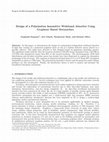
Progress In Electromagnetics Research Letters, 2019
In this paper, we demonstrate the design of a polarization-independent wideband absorber of light... more In this paper, we demonstrate the design of a polarization-independent wideband absorber of light that consists of a perforated graphene sheet on top of a lossless dielectric spacer placed on a metallic reflector. The single layer absorber is duly designed based on impedance matching concept. The simulated results indicate that the structure produces 0.98 THz broad absorption from 1.80 THz to 2.72 THz with absorptivity larger than 90% at the normal incidence. The electromagnetic (EM) field distributions and the plots of surface power loss density have been illustrated to explain the absorption mechanism of the structure. The variation of chemical potential from 0.8 to 1.2 eV keeps 90% absorption bandwidth as much as 1 THz band. The polarization-insensitive feature and the properties under oblique incidence are also investigated. Finally, the interference theory is used to analyze and interpret the broadband absorption mechanism.
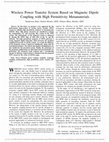
IEEE Antennas and Wireless Propagation Letters, 2019
In this letter, we present a new approach for the performance improvement of wireless power trans... more In this letter, we present a new approach for the performance improvement of wireless power transfer (WPT) system by utilizing high permittivity property of metamaterials (MTMs). Here, fully planar structures are considered to design the transmitting (Tx) and receiving (Rx) section of the WPT system. The performance of the proposed system is enhanced by placing the MTM slabs at both sides of the Tx and Rx elements. The high permittivity property of MTM generates a strong magnetic dipole behaviour which increases the magnetic coupling between the Tx and Rx section. As a result, the efficiency of the proposed system is improved significantly along with the transmission distance. The lateral and angular misalignments are also studied for the presented system. Finally, the prototypes of the proposed configuration are fabricated and measurements are performed. The measured result confirms that a considerable amount of efficiency improvement is obtained from the proposed WPT system by the virtue of MTMs usage.
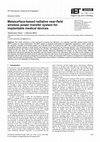
IET Microwaves, Antennas & Propagation, 2019
This article presents a novel approach to improve the efficiency of a radiative near-field wirele... more This article presents a novel approach to improve the efficiency of a radiative near-field wireless power transfer (WPT) system by using metasurface. The WPT system is designed particularly for implantable applications, which operate at the industrial, scientific, and medical (ISM) 2.40-2.48 GHz band. To construct the WPT link, a patch antenna is used as the transmitting element whereas a small planar loop antenna is considered as the receiving element. The receiving antenna is implanted under the skin tissue model operating at 2.45 GHz. The metasurface with a high refractive index is placed above the surface of the skin layer to improve the power transfer efficiency. Regarding the motion of the human body, different misalignment tolerances between the transmitter and the implant receiver are discussed. Also, the effect in the change of the skin property and placement depth of the Rx antenna inside the skin tissue model is studied. Furthermore, the study of specific absorption rate for the proposed configuration is performed. Finally, the proposed WPT system is designed and experimentally verified with and without metasurface. The experimental result confirms a significant amount of improvement in power transfer efficiency due to the integration of metasurface.
International Journal of RF and Microwave Computer-Aided Engineering, 2019
This article proposes the use of a magnetic metamaterial (MTM) slab over the ground plane of a wi... more This article proposes the use of a magnetic metamaterial (MTM) slab over the ground plane of a wire monopole antenna to improve its directivity. In this regard, mu very large (MVL) behavior of the metamaterial is utilized for enhancing the directivity of the monopole. Despite the directivity enhancement of about 5 dB, an improved bandwidth of 35% is obtained for the proposed configuration. Initially, a 2 × 3 array of a single MTM slab has been placed over the ground plane of the monopole. It is shown that, over the whole working band, a significant directivity improvement is maintained compared to the unloaded monopole. Further, the directivity performance has been investigated with different combination of MTM slab.











Uploads
Papers by Tarakeswar Shaw